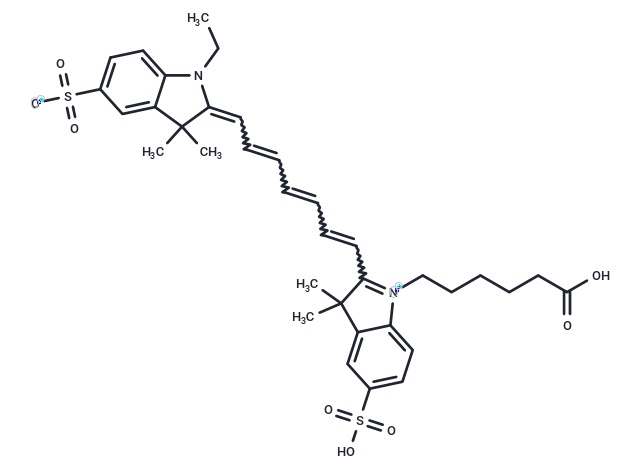Shopping Cart
Remove All Your shopping cart is currently empty
Your shopping cart is currently empty
CY7 (Sulfo-Cyanine7) is a fluorescence labeling agent (Ex=750 nm, Em=773 nm). Cy7 is used for labeling oligonucleotides, antibodies, peptides, and proteins.

| Pack Size | Price | USA Warehouse | Global Warehouse | Quantity |
|---|---|---|---|---|
| 1 mg | $54 | In Stock | In Stock | |
| 5 mg | $118 | In Stock | In Stock | |
| 10 mg | $165 | In Stock | In Stock | |
| 25 mg | $337 | In Stock | In Stock | |
| 50 mg | $472 | - | In Stock | |
| 100 mg | $678 | Inquiry | Inquiry | |
| 200 mg | $943 | Inquiry | Inquiry | |
| 1 mL x 10 mM (in DMSO) | $177 | In Stock | In Stock |
| Description | CY7 (Sulfo-Cyanine7) is a fluorescence labeling agent (Ex=750 nm, Em=773 nm). Cy7 is used for labeling oligonucleotides, antibodies, peptides, and proteins. |
| Cell Research | Instructions for use I. Reagent preparation 1. Mother solution preparation: It is necessary to use an appropriate solvent (such as DMSO or water) to dissolve. The specific concentration is determined according to the experimental requirements. The dissolution concentration is usually 0.1-1 mg/mL; if it is used to label molecules, the concentration of the reagent can be adjusted by the solvent as needed. II. Operation steps 1. Labeling process: 1) Protein or antibody labeling: Mix CY7 dye with the target molecule (such as an antibody or protein). Incubate at 4°C for 1-2 hours to ensure that the dye binds to the molecule. Sulfated CY7 (Sulfo-Cyanine7) is usually used to enhance the solubility and binding stability of the dye. Note: Unbound dye can be removed by centrifugation to ensure that the labeled molecule is pure. 2) Peptide and oligonucleotide labeling: For peptides or oligonucleotides, the labeling process is similar to that of proteins or antibodies, but the labeling reaction is usually faster and can be completed in a shorter time (about 30 minutes to 1 hour). 2. Reaction conditions: 1) During the labeling process, phosphate buffered saline (PBS) or other physiological buffers are usually used to ensure that the pH value is suitable for the binding of molecules and dyes. 2) If necessary, a higher concentration of CY7 (such as 10–50 μM) can be used to ensure effective labeling. 3. Removal of unreacted dye: After the reaction is completed, use dialysis, gel filtration, or ultrafiltration to remove unbound dye and reduce background noise. 5. Fluorescence measurement: Fluorescence detection of labeled molecules is performed using an excitation wavelength of 750 nm and an emission wavelength of 773 nm for analysis. Detection can be performed using a fluorescence microscope, flow cytometer, or near-infrared imaging system. Note: On these devices, CY7 has a strong fluorescence signal and is suitable for use in deep tissue imaging, animal models, and cell studies. 6. Data analysis: 1) Analyze the changes in fluorescence intensity to determine the location, concentration, and distribution of the labeled molecules. 2) Data processing can be further performed using a standard curve or by comparing the experimental group with the control group. Notes: 1. Solubility: CY7 dye has good solubility, but the dye should be avoided from binding to non-specific molecules when used. 2. Stability: CY7 fluorescent dye is highly sensitive to light, so strong light exposure should be avoided in the experiment to prevent photobleaching of the signal. 3. Reaction time: Too long labeling time may lead to non-specific binding, while too short time may lead to incomplete labeling. Therefore, the labeling time should be optimized according to the specific experimental requirements. 4. Labeling efficiency: If the labeling efficiency is low, the concentration of the dye can be adjusted or a longer incubation time can be used to improve the labeling effect. |
| Synonyms | Sulfo-Cyanine7 |
| Molecular Weight | 682.85 |
| Formula | C35H42N2O8S2 |
| Cas No. | 943298-08-6 |
| Smiles | CCN1C(=CC=CC=CC=CC2=[N+](CCCCCC(O)=O)c3ccc(cc3C2(C)C)S(O)(=O)=O)C(C)(C)c2cc(ccc12)S([O-])(=O)=O |
| Relative Density. | no data available |
| Storage | store at low temperature,keep away from direct sunlight | Powder: -20°C for 3 years | In solvent: -80°C for 1 year | Shipping with blue ice/Shipping at ambient temperature. | |||||||||||||||||||||||||||||||||||
| Solubility Information | DMSO: 30 mg/mL (43.93 mM), Sonication is recommended. H2O: 50 mg/mL (73.22 mM), Sonication is recommended. | |||||||||||||||||||||||||||||||||||
| In Vivo Formulation | 10% DMSO+40% PEG300+5% Tween-80+45% Saline: 2 mg/mL (2.93 mM), Sonication is recommeded. Please add the solvents sequentially, clarifying the solution as much as possible before adding the next one. Dissolve by heating and/or sonication if necessary. Working solution is recommended to be prepared and used immediately. The formulation provided above is for reference purposes only. In vivo formulations may vary and should be modified based on specific experimental conditions. | |||||||||||||||||||||||||||||||||||
Solution Preparation Table | ||||||||||||||||||||||||||||||||||||
DMSO/H2O
H2O
| ||||||||||||||||||||||||||||||||||||
| Size | Quantity | Unit Price | Amount | Operation |
|---|

Copyright © 2015-2025 TargetMol Chemicals Inc. All Rights Reserved.